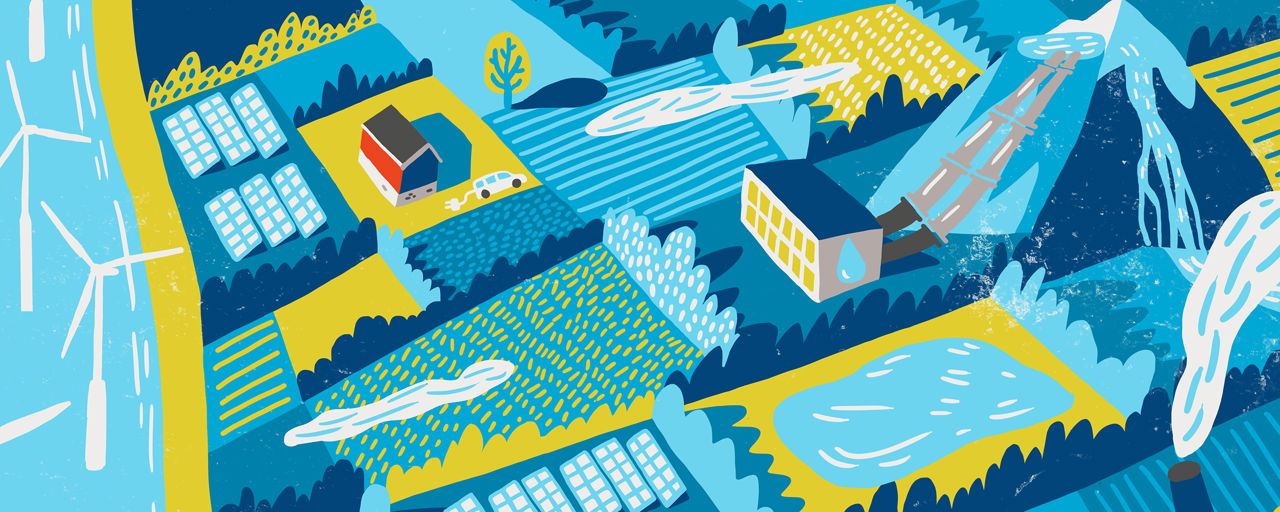
Greater action needed to shift global course to meet climate target
Statkraft’s annual Low Emissions Scenario urges greater action to shift global course to come close to a 1.5-degree climate target. Renewables remain at the core of this strategy, but we won’t succeed without clean hydrogen, according to the report.
“The world has been called to arms, to work in unison to slow the warming of our planet. It’s the mission of a lifetime, one that will define our generation. With the world slowly re-opening, so too are emissions returning to pre-pandemic levels, reinforcing our belief that the only way towards a 1.5-degree path is through the energy transition,” says Statkraft Chief Executive Officer Christian Rynning-Tønnesen.
Kevin O’Donovan, Managing Director of Statkraft Ireland added, “The solution to climate change is renewable energy - our world is depending on it. In Ireland, we have very ambitious climate targets and we have the natural resources, and the expertise, to meet them. But we need to ensure the political will is matched with proper resourcing and a sense of urgency about what exactly is required.”
“As well as a sustained focus on wind and solar, it’s clear that hydrogen, as well as grid services, is going to play a vital role in the global energy transition. This will need a very clear and deliberate focus by all in the sector.”
Each year, Europe’s largest renewable energy generator develops its Low Emissions Scenario, analysing developments in the global energy markets. The analysis is used as a foundation for Statkraft’s future investments and for the sixth consecutive year, we now share our key findings:
GREEN INVESTMENTS: Growth in renewable energy is “unstoppable”
Green investments increased in 2020 despite the economic downturn caused by the pandemic. Investments in renewable power was 7% higher in 2020 than in 2019.
Renewable energy is already in most places cheaper than fossil fuels when investing in new capacity. Solar and wind technologies outcompete existing coal and gas power plants in more and more places.
Costs are on a declining trend. In general, for one euro invested in solar PV and wind today you get around four times the output compared to what you did ten years ago.
Solar power capacity will grow by a factor of 21, and wind power by a factor of 7 between today to 2050. Solar and wind power will supply about two thirds of the global power system.

ELECTRIFICATION: Electrification cuts emissions locally and globally
Electrification is the main tool for cutting CO2 emissions. The share of electricity in final global energy demand will more than double to reach 47% in 2050.
Energy saved is the most environmentally friendly form of energy. Electricity is more effective than fossil energy sources in most applications. In for example heating up a house, a heat pump needs merely 1/3 of the energy compared to a gas boiler. The same goes for electric vehicles, that require approximately 1/3 of the energy fossil fuel vehicles require to go the same distance.
Emissions will be eliminated if the electricity originates from renewable energy sources. Electricity production from a gradually more renewable energy sector is the key to decarbonization in the Low Emissions Scenario.
2020 was a good year for electric vehicles. Global sales of battery-electric cars increased by 40%, even if total car sales fell.
The Low Emissions Scenario estimates that almost all new lighter vehicles will be battery-powered, while around half of new heavier vehicles will run on battery or hydrogen in 2050 worldwide.
FROM 2 DEGREES TO 1.5 DEGREES: Need to dramatically scale up transition
The combined effect of lower renewable energy costs and stronger climate policies will result in carbon emissions following a 2-degree pathway. Stopping global warming at 1.5 degrees, however, will require a substantial increase in both political ambitions and pace of global action.
2020 saw record high buildout of solar and wind power. But we need to install more than twice as much every year to 2050 to limit global warming to two degrees.
GREEN HYDROGEN: Fueling the race to net zero
Green hydrogen is necessary to limit climate change to Paris Agreement levels. Regional hydrogen markets and seasonal storage become increasingly attractive with higher power price variation.
Hydrogen will play a significant role in the 2050 energy system. On a windy day, electrolysers run by wind power can produce tons of green hydrogen. Electrolysers and storages combined can provide industry with a steady flow of green hydrogen.
About 10% (9.6%) of global power demand will come from green hydrogen production in 2050 and more than 20% for Europe in the Low Emissions Scenario.
The costs of electrolysers have fallen by 60% over the last five years. This decline is expected to continue due to increased automation, standardization, and technology improvements. We expect that investment costs for green hydrogen production will fall an additional 60% by 2050. Falling costs of both renewable energy and electrolysers will make an increasingly attractive business case for green hydrogen.
The majority of clean hydrogen will go to industry: both to replace existing hydrogen feedstock and remove emissions in industries where direct electrification is impossible or costly, e.g. the steel industry.





















